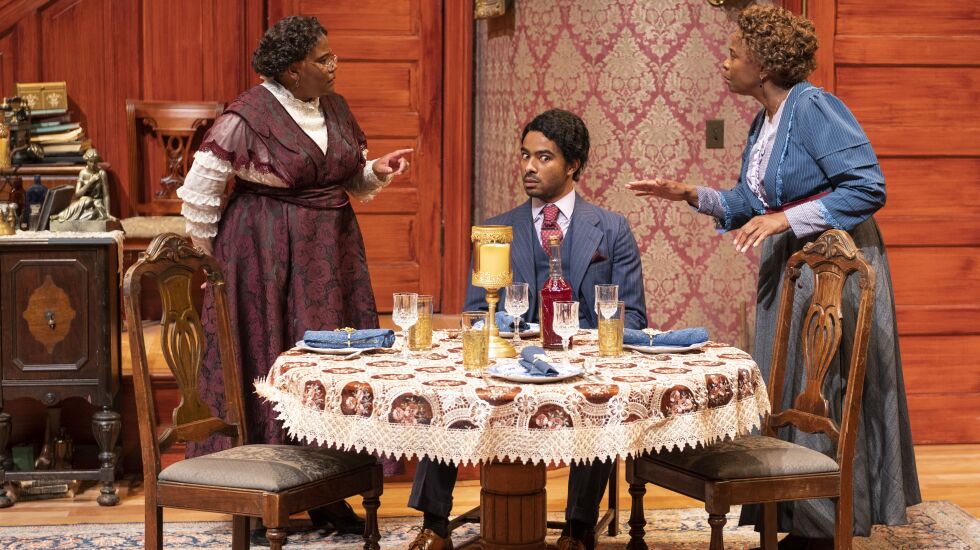
As an art form, stage comedies tend to have shorter lives than dramas.
There are exceptions, of course. Shakespeare’s comedies have lasted just as well as his tragedies. But of course, that’s Shakespeare. Moliere similarly sits in a league of his own. And the American musical comedy — well, that really must be considered a separate art form altogether.
Comedy tends to be more socially specific than drama, with style, theme and content more likely to lose their comic bite or relevance, sometimes tilting from being edgy into being offensive. That also explains why film comedies don’t suffer the same tendency for obsolescence; they exist as a type of time capsule, unlike plays, which need to be re-embodied and made funny anew when produced for a contemporary audience.
All of this serves to point out the rarity of a play like “Arsenic and Old Lace,” a comedy by Joseph Kesselring that was a huge Broadway hit in the early ’40s, and that has managed to survive as a relative staple of the American stage repertoire.
That survival might be partly explained by the popularity of the Frank Capra-directed movie version starring Cary Grant, which was filmed in 1941 but kept on the shelf until a few years later when the Broadway production closed. But there are plenty of other stage comedies that became films but didn’t continue to be produced. (A nod here has to be made to Michael Frayn’s farce “Noises Off,” another exception that proves the rule.)
So what is it about “Arsenic and Old Lace” that explains its longevity and appeal?
The current Court Theatre production is a darn good place to start. It’s a faithful and lovingly detailed production of the play, cast with a mostly African American ensemble that genuinely seems to be having a blast.
First off, it’s really funny. Maybe not often rolling in the aisles funny, but always funny pleasurable. Under Ron OJ Parson’s direction, the play moves as it needs to between a bit of realism, heavy doses of screwball goofiness, some outright farce — the physical humor here is particularly effective — and a good comic scare or two.

Most importantly, and almost certainly the essential ingredient of the play’s success, the central characters are genuinely likable company, the most appealingly sweet and well-meaning serial murderers ever written. Played here with wonderful comic timing and understated dryness by TayLar and Celeste Williams, Abby and Martha Brewster, respectively, are the epitome of generosity and kindness to their Brooklyn neighbors. They just love doing favors for everyone, and they consider it a particularly enjoyable favor to poison lonely old men, whom they are convinced are much happier dead than alive.
They’ve just completed an even dozen when comic chaos ensues as their nephew Mortimer (Eric Gerard in the Cary Grant role) discovers a body and sets out to both stop his aunts — not easy to do, they love killing old men so much — and to protect them from the police, who in this depiction embody the older cop stereotype (remember, comedy is social), well-intentioned but dumb and perennially hungry.
Add in Brewster brothers Teddy (Allen D. Edge), who thinks he’s Teddy Roosevelt, and prodigal sadistic killer Jonathan (AC Smith), whose tag-along plastic surgeon (Guy von Swearingen) has changed Jonathan’s face to match the Boris Karloff of “Frankenstein,” and you get a joyful mix of the macabre and the amusing.
I found Smith’s performance, so needily vulnerable and so menacing at the same time, and his hilariously brow-accentuating makeup (credited to Rebecca A. Scott designs), to be reliably the funniest elements on stage, which I don’t think is usually the case. And the design work here is really impeccable, particularly John Culbert’s set. You can admire the detail he’s put into it, such as the beautiful staircase railing, and then be surprised when Gerard’s Mortimer manages to use it to slide down in a hurry when he’s alarmed, as usual, at his aunts’ behavior.
There’s something deeper here if you care to analyze it. It’s certainly not coincidental that the Brewster aunts are named after the wives of our nation’s first two presidents. Kesselring definitely saw in them the innocent and smiling façade of a darker American foundation. The casting of the Brewsters as an African American family manages, intriguingly, to both dampen that and emphasize it.
But most of all, the play and production both just work as comedy, the humorous dissonance of innocent delight and death proving to be perennial. I left thankful for the shenanigans.







